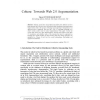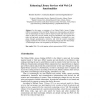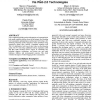IADIS
2008
14 years 2 months ago
2008
Recent years have seen a new generation of `digital students' emerging in the developed world. Digital students are young adults who have grown up with digital technologies i...
IIR
2010
14 years 2 months ago
2010
Thanks to the continuous growth of collaborative platforms like YouTube, Flickr and Delicious, we are recently witnessing to a rapid evolution of web dynamics towards a more `soci...
COMMA
2008
14 years 2 months ago
2008
: Students, researchers and professional analysts lack effective tools to make personal and collective sense of problems while working in distributed teams. Central to this work is...
BIS
2008
14 years 2 months ago
2008
Abstract. Web 2.0, also known as the Social Web, marks a new philosophy where users are both the main actors and the content producers: users write blogs and comments, they tag, li...
BIS
2007
14 years 2 months ago
2007
The recent evolution of the Web, now designated by the term Web 2.0, has seen the appearance of a huge number of resources created and annotated by users. However the annotations ...
ERCIMDL
2008
Springer
14 years 2 months ago
2008
Springer
In this paper, a prototype of an Online Public Access Catalog (OPAC) is presented. This new OPAC features new functionalities and utilizes web 2.0 technologies in order to deliver ...
CDVE
2008
Springer
14 years 2 months ago
2008
Springer
Abstract. "Web 2.0" is a term frequently mentioned in media - apparently, applications such as Wikipedia, Social Network Services, Online Shops with integrated recommende...
HT
2010
ACM
14 years 2 months ago
2010
ACM
1 Tags are an important information source in Web 2.0. They can be used to describe users’ topic preferences as well as the content of items to make personalized recommendations....
CANDT
2009
14 years 4 months ago
2009
Once acquainted with the modern information and communication tools made available with the advent of the Internet, five Brazilian rural communities participating in a pilot proje...
CANDT
2009
14 years 4 months ago
2009
Self-focus is a novel way of understanding a type of bias in community-maintained Web 2.0 graph structures. It goes beyond previous measures of topical coverage bias by encapsulat...



